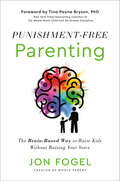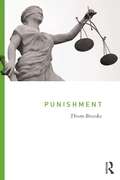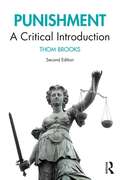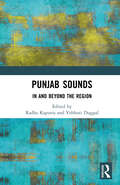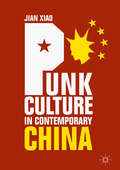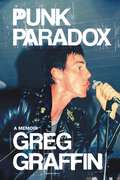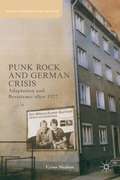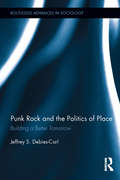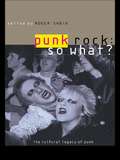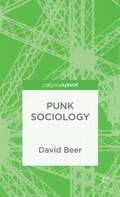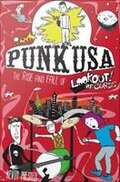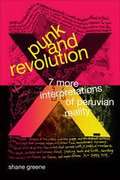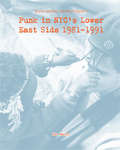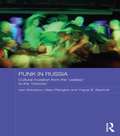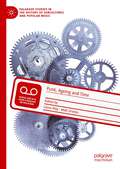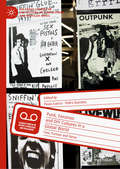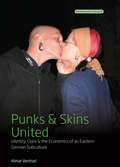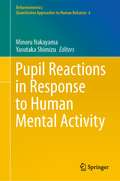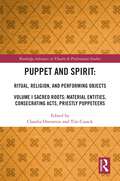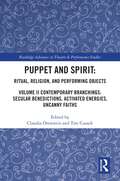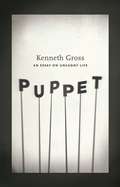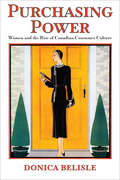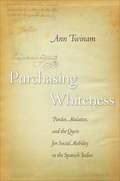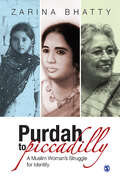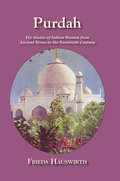- Table View
- List View
Punishment-Free Parenting: The Brain-Based Way to Raise Kids Without Raising Your Voice
by Jon FogelA no-judgment, simple-to-follow step-by-step parenting guide to help you manage your emotions, meet your child&’s needs with empathy, and create a calmer home—without ever resorting to threats or punishmentEvery parent has had that painful moment they realize there must be a better way to raise kids than the old-school yelling, threats, bribes, and punishment way.For Jon Fogel, that realization set him on a path toward wholeness: understanding himself, learning about the brain, and empowering parents to raise kids who live physically, mentally, and emotionally healthy lives. In just a few short years, he became an inspiration to more than a million people around the world who were also striving to do better and become the best parents they can be.Now, with Punishment-Free Parenting, Fogel—parenting educator, pastor, and father of four—brings to parents the hard-won wisdom from his research and work as a parenting coach. With memorable stories, advice, and compassionate insight, he offers moms and dads a clear path to their own wholeness as parents—from learning to recognize and name their own emotional triggers to responding with a deeper awareness of their children&’s developmental processes. What emerges is a collaborative partnership with children—free from the drama and pain of punishment.In pages packed with the most helpful research findings from child developmental psychology, neurology, and pediatric medicine, readers will meet other parents just like them and children just like their own who have learned to use the tools and tips that Fogel provides. Punishment-Free Parenting is the simple, accessible, no-judgment book for parents who want the support and guidance of a dad just like them.
Punishment: 2nd Edition (Crime And Punishment: Critical Essays In Legal Philosophy Ser.)
by Thom BrooksPunishment is a topic of increasing importance for citizens and policymakers. Why should we punish criminals? Which theory of punishment is most compelling? Is the death penalty ever justified? These questions and many others are addressed in this highly engaging guide. Punishment is a critical introduction to the philosophy of punishment, offering a new and refreshing approach that will benefit readers of all backgrounds and interests. The first critical guide to examine all leading contemporary theories of punishment, this book explores – among others – the communicative theory of punishment, restorative justice, and the unified theory of punishment. Thom Brooks examines several case studies in detail, including capital punishment, juvenile offending, and domestic abuse. Punishment highlights the problems and prospects of different approaches in order to argue for a more pluralistic and compelling perspective that is novel and groundbreaking. Punishment is a textbook designed to introduce both undergraduate and postgraduate students to the topic of punishment. It will be essential for undergraduate students in: philosophy, criminal justice, criminology, justice studies, law, politics, and sociology.
Punishment: A Critical Introduction (Crime And Punishment: Critical Essays In Legal Philosophy Ser.)
by Thom BrooksPunishment is a topic of increasing importance for citizens and policymakers. Why should we punish criminals? Which theory of punishment is most compelling? Is the death penalty ever justified? These questions and many more are examined in this highly engaging and accessible guide. Punishment is a critical introduction to the philosophy of punishment, offering a new and refreshing approach that will benefit readers of all backgrounds and interests. The first comprehensive critical guide to examine all leading contemporary theories of punishments, this book explores – among others – retribution, the communicative theory of punishment, restorative justice and the unified theory of punishment. Thom Brooks applies these theories to several case studies in detail, including capital punishment, juvenile offending and domestic violence. Punishment highlights the problems and prospects of different approaches in order to argue for a more pluralistic and compelling perspective that is novel and ground-breaking. This second edition has extensive revisions and updates to all chapters, including an all-new chapter on the unified theory substantively redrafted and new chapters on cyber-crimes and social media as well as corporate crimes. Punishment is essential reading for undergraduate and graduate students in philosophy, criminal justice, criminology, justice studies, law, political science and sociology.
Punjab Sounds: In and Beyond the Region
by Radha Kapuria Vebhuti DuggalPunjab Sounds nuances our understanding of the region's imbrications with sound. It argues that rather than being territorially bounded, the region only emerges in ‘regioning’, i.e., in words, gestures, objects, and techniques that do the region. Regioning sound reveals the relationship between sound and the region in three interlinked ways: in doing, knowing, and feeling the region through sound.The volume covers several musical genres of the Punjab region, including within its geographical remit the Punjabi diaspora and east and west Punjab. It also provides new understandings of the role that ephemeral cultural expressions, especially music and sound, play in the formulation of Punjabi identity. Featuring contributions from scholars across North America, South Asia, Europe, and the UK, it brings together diverse perspectives. The chapters use a range of different methods, ranging from computational analysis and ethnography to close textual analysis, demonstrating some of the ways in which research on music and sound can be carried out.The chapters will be relevant for anyone working on Punjab’s music, including the Punjabi diaspora, music, and sound in the Global South. Moreover, it will be useful for undergraduate and postgraduate students in the following areas: ethnomusicology, cultural studies, film studies, music studies, South Asian studies, Punjab studies, history, and sound studies, among others.
Punk Culture in Contemporary China
by Jian XiaoThis book explores for the first time the punk phenomenon in contemporary China. As China has urbanised within the context of explosive economic growth and a closed political system, urban subcultures and phenomena of alienation and anomie have emerged, and yet, the political and economic differences between China and western societies has ensured that these subcultures operate and are motivated by profoundly different structures. This book will be of interest to cultural historians, media studies and urban studies researchers, and (ex-) punk rockers.
Punk Paradox: A Memoir
by Greg GraffinFrom the legendary singer-songwriter of Bad Religion comes a historical memoir and cultural criticism of punk rock&’s evolution. Greg Graffin is the lead vocalist and songwriter of Bad Religion, recently described as &“America's most significant punk band.&” Since its inception in Los Angeles in 1980, Bad Religion has produced 18 studio albums, become a long-running global touring powerhouse, and has established a durable legacy as one of the most influential punk rock bands of all time. Punk Paradox is Graffin's life narrative before and during L.A. punk's early years, detailing his observations on the genre's explosive growth and his band's steady rise in importance. The book begins by exploring Graffin&’s Midwestern roots and his life-changing move to Southern California in the mid-&’70s. Swept up into the burgeoning punk scene in the exhilarating and often-violent streets of Los Angeles, Graffin and his friends formed Bad Religion, built a fanbase, and became a touring institution. All these activities took place in parallel with Graffin's never ceasing quest for intellectual enlightenment. Despite the demands of global tours, recording sessions, and dedication to songwriting, the author also balanced a budding academic career. In so doing, he managed to reconcile an improbable double-life as an iconic punk rock front man and University Lecturer in evolution. Graffin&’s unique experiences mirror the paradoxical elements that define the punk genre—the pop influence, the quest for society&’s betterment, music&’s unifying power—all of which are prime ingredients in its surprising endurance. Fittingly, this book argues against the traditional narrative of the popular perception of punk. As Bad Religion changed from year to year, the spirit of punk—and its sonic significance—lived on while Graffin was ever willing to challenge convention, debunk mythology, and liberate listeners from the chains of indoctrination. As insightful as it is exciting, this thought-provoking memoir provides both a fly on the wall history of the punk scene and astute commentary on its endurance and evolution.
Punk Rock And German Crisis
by Cyrus Shahan1977 is usually associated with West German terrorism, but it witnessed another cultural watershed: punk music. A new reckoning with the legacy of political and aesthetic spaces, this book argues the centrality of punk music for understanding crises of state and terrorist violence, American racism and German fascism, and aesthetic production.
Punk Rock and the Politics of Place: Building a Better Tomorrow (Routledge Advances in Sociology)
by Jeffrey S. Debies-CarlThis book is an ethnographic investigation of punk subculture as well as a treatise on the importance of place: a location with both physical form and cultural meaning. Rather than examining punk as a "sound" or a "style" as many previous works have done, it investigates the places that the subculture occupies and the cultural practices tied to those spaces. Since social groups need spaces of their own to practice their way of life, this work relates punk values and practices to the forms of their built environments. As not all social groups have an equal ability to secure their own spaces, the book also explores the strategies punks use to maintain space and what happens when they fail to do so.
Punk Rock: The Cultural Legacy of Punk
by Roger SabinIt's now over twenty years since punk pogo-ed its way into our consciousness. Punk Rock So What?brings together a new generation of academics, writers and journalists to provide the first comprehensive assessment of punk and its place in popular music history, culture and myth. The contributors, who include Suzanne Moore, Lucy OBrien, Andy Medhurst, Mark Sinker and Paul Cobley, challenge standard views of punk prevalent since the 1970s. They: * re-situate punk in its historical context, analysing the possible origins of punk in the New York art scene and Manchester clubs as well as in Malcolm McClarens brain* question whether punk deserves its reputation as an anti-fascist, anti-sexist movement which opened up opportunities for women musicians and fans alike. * trace punks long-lasting influence on comics, literature, art and cinema as well as music and fashion, from films such as Sid and Nancy and The Great Rock n Roll Swindle to work by contemporary artists such as Gavin Turk and Sarah Lucas.* discuss the role played by such key figures as Johnny Rotten, Richard Hell, Malcolm McClaren, Mark E. Smith and Viv Albertine. Punk Rock Revisited kicks over the statues of many established beliefs about the meaning of punk, concluding that, if anything, punk was more culturally significant than anybody has yet suggested, but perhaps for different reasons.
Punk Sociology
by David BeerThis book explores the possibility of drawing upon a punk ethos to inspire and invigorate sociology. It uses punk to think creatively about what sociology is and how it might be conducted and aims to fire the sociological imaginations of sociologists at any stage of their careers, from new students to established professors.
Punk USA
by Kevin PrestedThrough hundreds of exclusive and original interviews, Punk USA documents an empire that was built overnight as Lookout sold millions of records and rode the wave of the second coming of punk rock until it all came crashing down. In 1987, Lawrence Livermore founded independent punk label Lookout Records to release records by his band The Lookouts. Forming a partnership with David Hayes, the label released some of the most influential recordings from California's East Bay punk scene, including a then-teenaged Green Day. Originally operating out of a bedroom, Lookout created "The East Bay Punk sound," with bands such as Crimpshrine, Operation Ivy, The Mr. T Experience, and many more. The label helped to pave the way for future punk upstarts and as Lookout grew, young punk entrepreneurs used the label as a blueprint to try their hand at record pressing. As punk broke nationally in the mid 90s the label went from indie outfit to having more money than it knew how to manage.
Punk and Revolution: Seven More Interpretations of Peruvian Reality
by Shane GreeneIn Punk and Revolution Shane Greene radically uproots punk from its iconic place in First World urban culture, Anglo popular music, and the Euro-American avant-garde, situating it instead as a crucial element in Peru's culture of subversive militancy and political violence. Inspired by José Carlos Mariátegui's Seven Interpretive Essays on Peruvian Reality, Greene explores punk's political aspirations and subcultural possibilities while complicating the dominant narratives of the war between the Shining Path and the Peruvian state. In these seven essays, Greene experiments with style and content, bends the ethnographic genre, and juxtaposes the textual and visual. He theorizes punk in Lima as a mode of aesthetic and material underproduction, rants at canonical cultural studies for its failure to acknowledge punk's potential for generating revolutionary politics, and uncovers the intersections of gender, ethnicity, class, and authenticity in the Lima punk scene. Following the theoretical interventions of Debord, Benjamin, and Bakhtin, Greene fundamentally redefines how we might think about the creative contours of punk subculture and the politics of anarchist praxis.
Punk in NYC's Lower East Side 1981-1991: Scene History Series, Vol 1 (Scene History Ser.)
by Ben NaderDrawing on both archival documents and original interviews, this zine explores the music of the era's bands, including Bad Brains, Cro-Mags, Agnostic Front, False Prophets, Urgent Fury, No Thanks, and Reagan Youth. At the same time, the scene is situated within the broader social context, from the election of Ronald Reagan to the Tompkins Square Riots. Woven throughout is the tragic story of New York City's most legendary anarcho-punk, Reagan Youth's Dave Insurgent.
Punk in Russia: Cultural mutation from the “useless” to the “moronic” (Routledge Contemporary Russia and Eastern Europe Series)
by Hilary Pilkington Ivan Gololobov Yngvar B SteinholtPunk culture is currently having a revival worldwide and is poised to extend and mutate even more as youth unemployment and youth alienation increase in many countries of the world. In Russia, its power to have an impact and to shock is well illustrated by the state response to activist collective and punk band Pussy Riot. This book, based on extensive original research, examines the nature of punk culture in contemporary Russia. Drawing on interviews and observation, it explores the vibrant punk music scenes and the social relations underpinning them in three contrasting Russian cities. It relates punk to wider contemporary culture and uses the Russian example to discuss more generally what constitutes 'punk' today.
Punk, Ageing and Time (Palgrave Studies in the History of Subcultures and Popular Music)
by Laura Way Matt GrimesTo date there has been no plotting of punk scholarship which speaks to ‘time’, yet there are some clear bodies of work pertaining to particular issues relevant to it, including ageing and/or the life course and punk, memory and/or nostalgia and punk, ‘punk history’, and archiving and punk. Punk, Ageing and Time is therefore a timely (pun intended) book. What this edited collection does for the first time is bring together contemporary investigations and discussions specifically around punk and ageing and/or time, covering areas such as: punk and ageing; the relationship between temporality and particular concepts relevant to punk (such as authenticity, DIY, identity, resistance, spatiality, style); and punk memory, remembering and/or forgetting. Multidisciplinary in nature, this book considers areas which have received very little to no academic attention previously.
Punk, Fanzines and DIY Cultures in a Global World: Fast, Furious and Xerox (Palgrave Studies in the History of Subcultures and Popular Music)
by Paula Guerra Pedro QuintelaSince the 1970 and 1980s, fanzines have constituted a zone of freedom of thought, of do-it-yourself creativity and of alternatives to conventional media. Along with bands, records and concerts, they became a vital part of the construction of punk 'scenes’, actively contributing to the creation and consolidation of communities. This book moves beyond the usual focus on Anglophone punk scenes to consider fanzines in international contexts. The introduction offers a theoretical, chronological and thematic survey for understanding fanzines, considering their contemporary polyhedral vitality. It then moves to consider the distinct social, historical and geographic contexts in which fanzines were created. Covering the UK, Portugal, Greece, Canada, Germany, Argentina, France and Brazil, as well as a wide range of standpoints, this book contributes to a more global understanding of the fanzine phenomenon.
Punks and Skins United: Identity, Class and the Economics of an Eastern German Subculture (Anthropology of Europe #5)
by Aimar VentselGermany has one of the liveliest and well-developed punk scenes in the world. However, punk in this country is not just a style-based music community. This book provides an anthropological examination of how punk reflects the larger changes and contradictions in post-reunification Germany, such as social segmentation, east-west tensions and local politics. Punk in eastern Germany is a reaction to the marginalization of the working class. As a cultural, social and economic niche, punks create their own controversial “substitute society” to compensate for their low status in mainstream society.
Pupil Reactions in Response to Human Mental Activity (Behaviormetrics: Quantitative Approaches to Human Behavior #6)
by Minoru Nakayama Yasutaka ShimizuThis book focuses on a development for assessing mental changes using eye pupil reactions, namely extracting emotional change from the response to evaluate the viewer's interest in visual information. The pupil of the eye reacts to both brightness and emotional state, including interest, enjoyment, and mental workload. Because pupillary change is a biological signal, various artifacts influence measurements of eye images. Technical procedures are required to extract mental activities from pupillary changes, and they are summarized here step by step, although some procedures contain earlier techniques such as analog video processing. This study examines the possibility of estimating the viewer's interest and enjoyment of viewing movies by measuring the dynamic pupillary changes, blinking, and subjective interest responses. In evaluation of pupil size, there was a significant difference in pupil size between the higher and the lower shot for the degree of subject interest response in each kind of movies. The first part of the book shows a pupil reaction model for brightness changes to extract mental activities. Pupil reactions were observed for various visual stimuli in brightness changes. With regard to the characteristics of pupillary changes, a model with a three-layer neural network was developed and the performance was evaluated. Characteristics of pupil reactions during model development are summarized here. The second part examines the possibility of estimating the viewer's interest and enjoyment of television programs by measuring dynamic pupillary changes, blinking, and subjective interest responses. The final part describes a development of estimation model of pupil size for blink artifact. The model development was able to estimate pupillary changes and pupil size while the viewer was blinking and was applied to pupillary changes in viewing television programs.
Puppet and Spirit: Volume I Sacred Roots: Material Entities, Consecrating Acts, Priestly Puppeteers (Routledge Advances in Theatre & Performance Studies)
by Claudia OrensteinThis anthology of essays aims to explore the many types of relationships that exist between puppets, broadly speaking, and the immaterial world. The allure of the puppet goes beyond its material presence as, historically and throughout the globe, many uses of puppets and related objects have expressed and capitalized on their posited connections to other realms or ability to serve as vessels or conduits for immaterial presence. The flip side of the puppet’s troubling uncanniness is precisely the possibilities it represents for connecting to discarnate realities. Where do we see such connections? How do we describe, analyze, and theorize these relationships? The first of two volumes, this book focuses on these questions in relation to long-established, traditional practices using puppets, devotional objects, and related items with sacred aspects to them or that perform ritual roles. Looking at performance traditions and artifacts from China, Indonesia, Korea, Mali, Brazil, Iran, Germany, and elsewhere, the essays from scholars and practitioners provide a range of useful models and critical vocabularies for addressing the ritual and spiritual aspects of puppet performance, further expanding the growing understanding and appreciation of puppetry generally. This book, along with its companion volume, offers, for the first time, robust coverage of this subject from a diversity of voices, examples, and perspectives.
Puppet and Spirit: Volume II Contemporary Branchings: Secular Benedictions, Activated Energies, Uncanny Faiths (ISSN)
by Claudia Orenstein Tim CusackThis anthology of essays, a companion to Puppet and Spirit: Ritual, Religion, and Performing Objects, Volume I, aims to explore the many types of relationships that exist between puppets, broadly speaking, and the immaterial world.The allure of the puppet goes beyond its material presence as, historically and throughout the globe, many uses of puppets and related objects have expressed and capitalized on their posited connections to other realms or ability to serve as vessels or conduits for immaterial presence. The flip side of the puppet’s troubling uncanniness is precisely the possibilities it represents for connecting to discarnate realities. Where do we see such connections in contemporary artistic work in various mediums? How do puppets open avenues for discussion in a world that seems to be increasingly polarized around religious values? How do we describe, analyze, and theorize the present moment? What new questions do puppets address for our times, and how does the puppet’s continued entanglement with these concerns trouble or comfort us? The essays in this book, from scholars and practitioners, provide a range of useful models and critical vocabularies for addressing this aspect of puppet performance, further expanding the growing understanding and appreciation of puppetry generally.This book, along with its companion volume, offers, for the first time, robust coverage of this subject from a diversity of voices, examples, and perspectives.
Puppet: An Essay on Uncanny Life
by Kenneth Gross&“Offering endless insights into the strange and archaic world of puppets . . . This is a book of literary mysticism, rich with accrued culture.&” —John Rockwell, The New York Times Book Review The puppet creates delight and fear. It may evoke the innocent play of childhood, or become a tool of ritual magic, able to negotiate with ghosts and gods. Puppets can be creepy things, secretive, inanimate while also full of spirit, alive with gesture and voice. In this eloquent book, Kenneth Gross contemplates the fascination of these unsettling objects—objects that are also actors and images of life. The poetry of the puppet is central here, whether in its blunt grotesquery or symbolic simplicity, and always in its talent for metamorphosis. On a meditative journey to seek the idiosyncratic shapes of puppets on stage, Gross looks at the anarchic Punch and Judy show, the sacred shadow theater of Bali, and experimental theaters in Europe and the United States, where puppets enact everything from Baroque opera and Shakespearean tragedy to Beckettian farce. Throughout, he interweaves accounts of the myriad faces of the puppet in literature—Collodi&’s cruel, wooden Pinocchio, puppetlike characters in Kafka and Dickens, Rilke&’s puppet-angels, the dark puppeteering of Philip Roth&’s Micky Sabbath—as well as in the work of artists Joseph Cornell and Paul Klee. The puppet emerges here as a hungry creature, seducer and destroyer, demon and clown. It is a test of our experience of things, of the human and inhuman. A book about reseeing what we know, or what we think we know, Puppet evokes the startling power of puppets as mirrors of the uncanny in life and art.
Purchasing Power: Women and the Rise of Canadian Consumer Culture (Studies in Gender and History)
by Donica BelisleExploring the roots of Canadian consumer culture, Purchasing Power uncovers the meanings that Canadians have attached to consumer goods. Focusing on women during the early twentieth century, it reveals that for thousands of Canadians between the 1890s and World War II, consumption was about not only survival, but also civic expression. Offering a new perspective on the temperance, conservation, home economics, feminist, and co-operative movements, this book brings women’s consumer interests to the fore. Due to their exclusion from formal politics and paid employment, many Canadian women turned their consumer roles into personal and social opportunities. They sought solutions in the consumer sphere to isolation, upward mobility, personal expression, and family survival. They transformed consumer culture into an arena of political engagement. Yet if Canadian women viewed consumption as a tool of empowerment, so did they wield consumption as a tool of exclusion. As Purchasing Power reveals, Canadian women of privileged race and class status tended to disparage racialized and lower income women’s consumer habits. In so doing, they constructed notions of taste that defined who – and who did not – belong in the modern Canadian nation.
Purchasing Whiteness: Pardos, Mulattos, and the Quest for Social Mobility in the Spanish Indies
by Ann TwinamThe colonization of Spanish America resulted in the mixing of Natives, Europeans, and Africans and the subsequent creation of a casta system that discriminated against them. Members of mixed races could, however, free themselves from such burdensome restrictions through the purchase of a gracias al sacar—a royal exemption that provided the privileges of Whiteness. For more than a century, the whitening gracias al sacar has fascinated historians. Even while the documents remained elusive, scholars continually mentioned the potential to acquire Whiteness as a provocative marker of the historic differences between Anglo and Latin American treatments of race. Purchasing Whiteness explores the fascinating details of 40 cases of whitening petitions, tracking thousands of pages of ensuing conversations as petitioners, royal officials, and local elites disputed not only whether the state should grant full whiteness to deserving individuals, but whether selective prejudices against the castas should cease. Purchasing Whiteness contextualizes the history of the gracias al sacar within the broader framework of three centuries of mixed race efforts to end discrimination. It identifies those historic variables that structured the potential for mobility as Africans moved from slavery to freedom, mixed with Natives and Whites, and transformed later generations into vassals worthy of royal favor. By examining this history of pardo and mulatto mobility, the author provides striking insight into those uniquely characteristic and deeply embedded pathways through which the Hispanic world negotiated processes of inclusion and exclusion.
Purdah to Piccadilly: A Muslim Woman’s Struggle for Identity
by Zarina BhattyTracing the life of Zarina Bhatty, a Muslim woman born and brought up in pre-Partition India, this memoir narrates the experiences of a woman who strove to break out of the stereotypical roles imposed by the society of her times. It chronicles her life over 80 years, portraying the political and social conditions of undivided and post-Independence India. Zarina’s story is a story of grit, perseverance and determination to battle against all odds —a story that was waiting to be told.
Purdah: Status Of Indian Women
by HauswirthFirst published in 2006. Routledge is an imprint of Taylor & Francis, an informa company.
